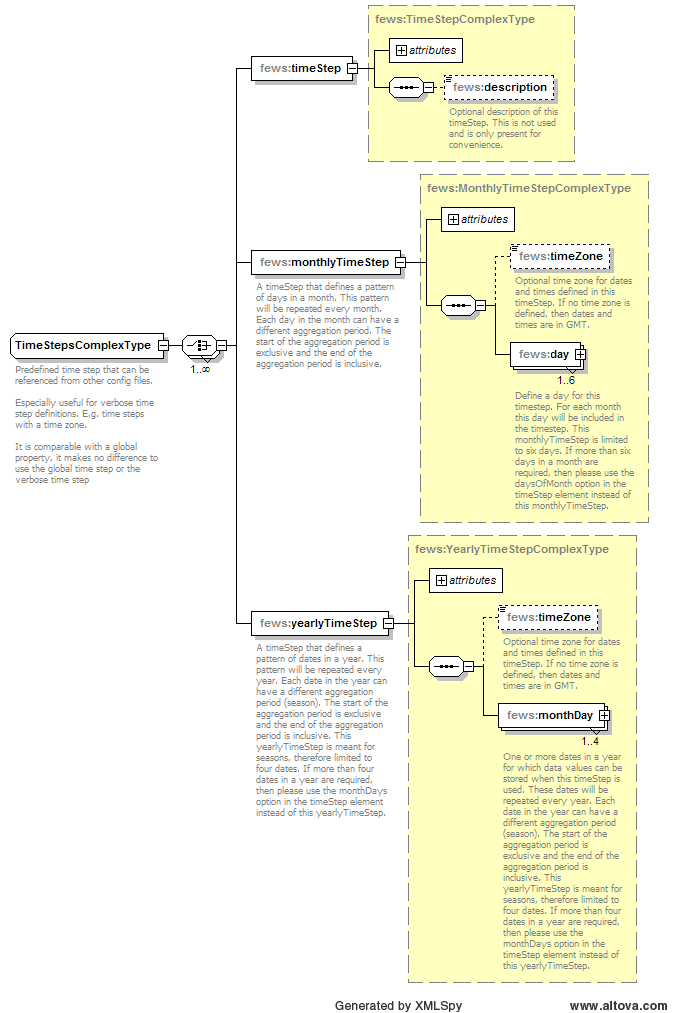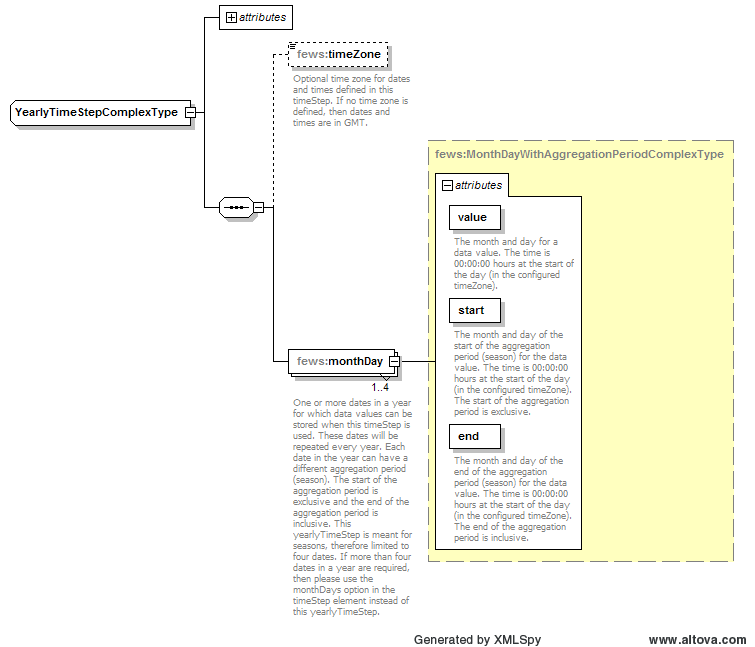...
| scrollbar |
|---|
...
| Excerpt | ||
|---|---|---|
| ||
Functionality to define qualifiers to time series, next to locationIds and parameterIds |
Function: | Configure predefined timesteps for a fews environment |
Where to Use? | To define verbose timesteps or to define yearly or monthly time steps |
Why to Use? | Yearly and monthly time steps can only be configured in the timesteps.xml. For verbose timesteps it might be |
Description: | Definition of timesteps which can be referenced from other configuration files |
Available since: |
|
Contents
| Table of Contents |
|---|
Overview
The timesteps.xml can be used to configure timesteps. This file is useful to define verbose timesteps and refer to the definition of these timesteps to
...
Below the schema of the TimeStep.xml configuration files.
timeStep
Attributes;
- id: Unique Id of level threshold. This id should be used when referencing to this definition from other configuration files.
The following link describes in detail of to configure a timestep.
httphttps://publicpublicwiki.deltares.nl/display/FEWSDOC/02+Data+Handling+in+DELFT-FEWS#id-FEWS#02DataHandlinginDELFT02DataHandlinginDELFT-FEWS-timeStep
yearlyTimeStep
A timeStep that defines a pattern of dates in a year. This pattern will be repeated every year.
...
If more than four dates in a year are required, then please use the monthDays option in the timeStep element instead of this yearlyTimeStep
Schema yearly time step
Below the schema of the yearly time step
Below a configuration example
| Code Block | ||||
|---|---|---|---|---|
| ||||
<yearlyTimeStep id="daily">
<monthDay start="--01-01" end="--01-02" value="--01-02"/>
<monthDay start="--04-02" end="--04-03" value="--04-03"/>
<monthDay start="--07-03" end="--07-04" value="--07-04"/>
<monthDay start="--10-04" end="--10-05" value="--10-05"/>
</yearlyTimeStep>
|
To define a yearly time step an id should be configured. Secondly the monthDays of the time steps should be configured.
In this example the yearly time step has 4 monthDays. The start attribute defines the start of the aggregation period and the
end tag defines the end of the aggregation period. The value defines the timestamp used to store the aggregated value.
When using the yearly timestep in combination with the accumulation transformations, the value determines a restart moment for the accumulation. For those situations it is advised to set the value at the start of the monthDay itselfseason.
Monthly time step
A timeStep that defines a pattern of days in a month. This pattern will be repeated every month. Each day in the month can have a different aggregation period. The start of the aggregation period is exclusive and the end of the aggregation period is inclusive.
...
Below the schema of the monthly time step.
Below a configuration example
| Code Block | ||||
|---|---|---|---|---|
| ||||
<monthlyTimeStep id="example"> <day start="01" end="02" value="02"></day> <day start="10" end="11" value="11"></day> </monthlyTimeStep> |
Weekly timestep
A timestep that defines a pattern of times in week. This pattern will be repeated every week (since 2014.01). In this example values stored for this timestep are stored on Sunday, 00:00. This could be useful if the default weekly time (Thursday) is not suitable.
| Code Block |
|---|
<weeklyTimeStep id="Week" label="week"> <sunday times="00:00"/> </weeklyTimeStep> |
Other examples
every day at 13:00
<timeStep times="13:00"/>
every day at 13:00 and 20:00
<timeStep times="13:00 20:00"/>
every hour at each half hour (0:30, 1:30, etc.)
<timeStep minutes="30"/>
every hour at 5 and 45 minutes
<timeStep minutes="05 45">
every 12th of the month
<timeStep daysOfMonth="12"/>
decade
<timeStep daysOfMonth="1 11 21"/>


